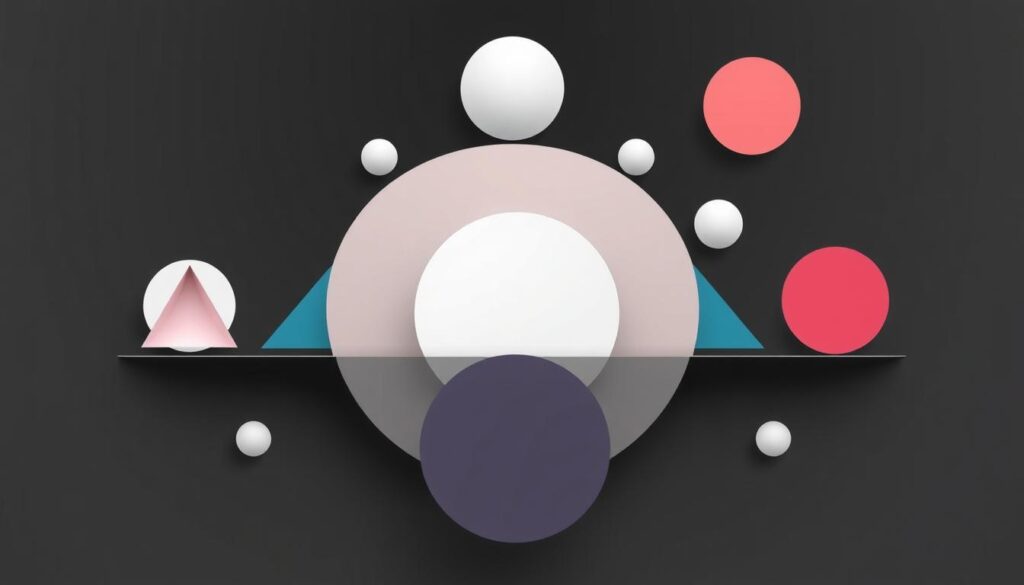Many design projects fall short due to a lack of foundational structure, leading to cluttered and ineffective visuals. Without applying core design principles, even the most creative ideas can fail to engage their intended audience. Research indicates that designs lacking balance, contrast, or unity often confuse viewers and diminish user engagement. To address this, designers should integrate key principles of design, such as contrast, proportion, and unity, to enhance clarity and visual appeal. This article provides a comprehensive guide on these principles and their significance in elevating your graphic design work.
How the Principles of Design Influence Visual Impact
The principles of design work together to create structure, flow, and visual interest within a layout. When applied correctly, they guide the eye, emphasize important elements, and balance visual weight effectively. Contrast, proportion, and unity are not isolated rules, they function simultaneously to support harmony across different sections.
Designers use these principles to ensure different elements don’t clash but instead complement each other. White space, for instance, lets smaller elements breathe while adding clarity to visual elements. Without structure, even the best elements of design can feel disjointed. Altogether, these principles influence how viewers feel and respond to a design project.
Why the Principles of Design Matter in Graphic Design?

Graphic designers rely on the principle of design to organize content and establish clear visual hierarchy. Without these foundational rules, visuals can lose clarity and fail to convey the intended message. Elements of a design, such as contrast and white space, function cohesively to capture attention and create harmony.
The basic principles of design also help improve consistency across layouts, regardless of complexity. Proportion ensures that smaller elements support the overall structure without disrupting flow. Unity ties everything together and creates a more immersive experience. Designers must apply these principles wisely to shape how users interact with visual design.
How Design Principles Shape Viewer Perception:
Viewer perception depends heavily on how the elements and principles of design are applied. The brain responds instinctively to patterns, balance, and visual weight, which these principles help establish.
-
Contrast separates elements that need to stand out without overwhelming the viewer.
-
Proportion aligns content into a structured format that feels natural and balanced.
-
Unity creates consistency, allowing different elements to feel like part of a whole.
-
White space guides the viewer’s eye and adds breathing room.
The Role of Visual Design in Effective Communication:
Visual design transforms ideas into a format the human brain processes quickly and clearly. The elements of design, including contrast, spacing, and shape, establish a direct channel between message and viewer.
-
It reduces misinterpretation by creating clean, organized layouts.
-
It improves attention span through effective use of white space and visual weight.
-
It conveys tone and intent using symmetry, color, and scale.
Contrast as a Tool for Emphasis and Clarity
Contrast helps elements stand out by separating them through tone, size, color, or shape. It clarifies purpose and improves readability, especially in web design where clarity is vital. For example, using a darker background behind a light button makes interaction easier. Visual elements that lack contrast tend to blend in and reduce impact. Contrast also establishes visual hierarchy, emphasizing key areas without adding clutter.
Additionally, it supports asymmetrical balance, offering more creative flexibility. Graphic design benefits greatly from strong contrast because it keeps the layout clean, intuitive, and eye-catching. Without contrast, different elements appear flat and confusing.
Proportion and Its Role in Balanced Design
Proportion refers to the relationship between different elements in terms of size and scale within a layout. Designers use it to direct attention and create balance, especially when combining smaller elements with larger focal points. For instance, using a dominant image next to smaller text draws viewers in while providing clear visual weight. Proportion not only influences how people perceive size but also how harmonious the design feels overall.
Additionally, well-used proportion brings structure to both symmetrical and asymmetrical balance. Whether in print or web design, proportion helps keep layouts intuitive and easy to follow. It’s particularly valuable in art and design, where storytelling through scale enhances meaning and visual flow.
How Proportion Enhances UX and UI Design:
| Aspect |
How Proportion Helps |
| Button Sizing |
Ensures call-to-action buttons are prominent and easy to click. |
| Text Hierarchy |
Establishes clear titles, subtitles, and body readability. |
| Layout Spacing |
Adds rhythm and flow to interface components. |
| Image-to-Text Balance |
Keeps visuals from overpowering or getting lost in the content. |
| Consistent Element Scaling |
Maintains structure across pages and screen sizes. |
Unity Brings Consistency to Every Design Element
Unity in a design helps tie different components together, allowing each element of the design to support the whole. Designers use it to create a sense of rhythm and consistency throughout the layout. Elements within a design, like typography, imagery, and spacing, need to function concurrently to convey a clear message. Otherwise, a layout may look disconnected and lose effectiveness. Moreover, using repeated elements to create a cohesive experience builds trust and visual stability. Graphic design principles such as unity implementing the principles ensures that all parts of your composition work together to achieve one clear, compelling design.
White Space Is More Than Empty Space
White space gives content room to breathe and adds structure throughout a design. Although it seems inactive, it carries visual rhythm and helps highlight important parts of your design. Graphic design rules do not require overcrowding every pixel, instead, they stress balance between form and void. Designers use white space strategically to increase legibility and focus, especially in UI design principles. It improves the overall flow of design composition by placing attention on what matters. Additionally, it supports unity in a design, making the viewer feel comfortable. Henceforth, white space remains a powerful tool, not just a background filler.
Applying Graphic Design Principles in UX and UI Design
Applying graphic design principles to UX design helps shape intuitive, aesthetically pleasing interfaces that users enjoy. Elements such as proportion, contrast, and white space guide interactions clearly and efficiently. UI design principles rely on balance and rhythm to enhance usability and avoid friction.
When used effectively, these fundamental principles simplify even complex flows. Altogether, design feels more intuitive when the elements in your design support both functionality and appearance, achieving clarity and confidence in user experience.
Real-World UX Design Examples That Apply the Principles:
-
Airbnb uses white space generously to highlight search tools and improve overall booking clarity.
-
Spotify’s use of proportion makes album covers stand out without overwhelming navigation.
-
Google’s homepage shows symmetrical design that balances content and brand logo harmoniously.
-
Dropbox applies contrast between background and call-to-action buttons to guide user behavior clearly.
-
Apple’s site layout maintains unity using consistent typography, spacing, and product presentation.
-
Canva’s interface shows how variety in design adds functionality without cluttering the user experience.
-
Trello uses visual rhythm by repeating column cards to form an easy-to-scan workflow.
-
LinkedIn uses consistent design principles for scalable content display across multiple devices.
The Value of Implementing the Principles in Design Projects

Implementing the principles brings clarity, harmony, and professional polish to any specific design. These principles of graphic design are not just visual theories, they improve communication and engagement measurably. A layout applying the key principles of design like balance, unity, and proportion ensures each element within a design plays its role effectively.
Design without these fundamentals feels random and confusing, eventually hurting both aesthetic and function. Moreover, using this design approach elevates the overall experience. Good design depends on consistency and planning, where the principles of design work together to deliver both beauty and clarity, especially in brand design.
How to Use the Principles in Daily Design Workflows:
Designers must use the principles consistently to streamline output across various design projects. Starting with a solid layout based on basic design principles reduces time spent revising later. For example, using a symmetrical design when appropriate adds balance without extra adjustments. Simultaneously, incorporating the Gestalt principles helps shape how users interpret grouped content.
Applying these fundamental principles of design in wireframes and mockups ensures clarity from the beginning. Designers should evaluate how each element of the design contributes to overall goals. Eventually, daily practice with these rules results in instinctive alignment, better consistency, and stronger visual storytelling in every project.
How Design Trends Reflect the Principles in Action
Modern design trends often highlight how the principles of design evolve while retaining their core purpose. For example, the shift toward minimalism emphasizes white space, clear hierarchy, and visual rhythm. Proportion in the principles helps define how interfaces scale across devices, especially in UX and UI design. Moreover, motion design relies on repeated elements to maintain rhythm and focus. Designers still rely on variety in design to break monotony while maintaining consistency. Therefore, these trends are not random, they reflect how design elements to create structured, appealing design while adapting to user behavior and technology. Trends shift, but principles remain.
Conclusion
Incorporating the principles of design into your projects ensures that each element contributes meaningfully to the overall composition. By applying concepts like contrast, proportion, and unity, you can create designs that are both aesthetically pleasing and functionally effective. These principles serve as a roadmap, guiding you to make informed decisions that enhance user experience and communication. As you continue to develop your design skills, consider how these principles can be tailored to fit various contexts and objectives. Which design principle do you find most impactful in your creative process?
FAQs
1. How does white space enhance a design?
White space improves readability and allows the design to breathe, preventing clutter.
2. Are these principles relevant to both beginners and professionals?
Absolutely, they provide a foundation for all levels of design expertise.
3. Do design principles apply to all types of design?
Yes, they are fundamental across various design disciplines, including graphic, interior, and product design.
4. How can I learn to apply these principles effectively?
Practice by analyzing existing designs and creating your own projects with these principles in mind.
5. What happens if I ignore design principles?
Ignoring them can lead to disorganized, confusing, and less effective designs.







